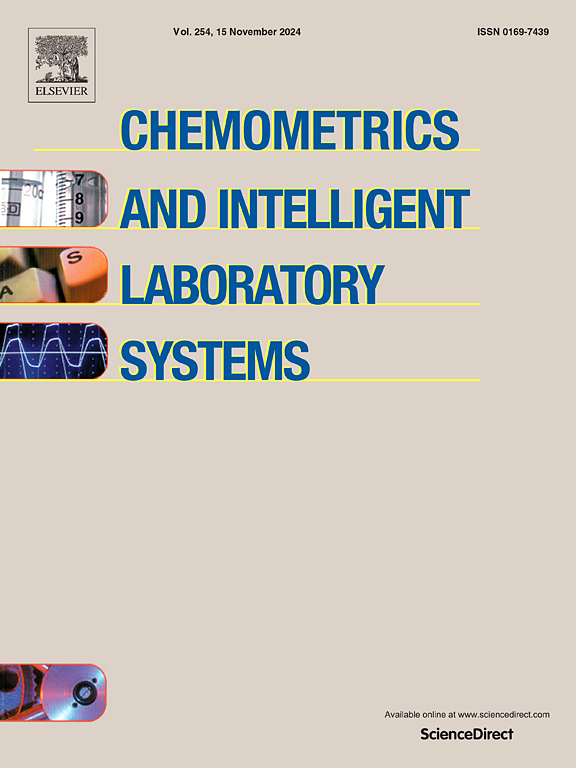Lactose prediction in dry milk with hyperspectral imaging: A data analysis competition at the “International Workshop on Spectroscopy and Chemometrics 2024”
IF 3.7
2区 化学
Q2 AUTOMATION & CONTROL SYSTEMS
Chemometrics and Intelligent Laboratory Systems
Pub Date : 2024-11-29
DOI:10.1016/j.chemolab.2024.105279
引用次数: 0
Abstract
In April 2024, the Vistamilk SFI Research Centre organized the fourth edition of the “International Workshop on Spectroscopy and Chemometrics — Spectroscopy meets modern Statistics”. Within this event, a data challenge was organized among workshop participants, focusing on hyperspectral imaging (HSI) of milk samples.
Milk is a complex emulsion comprising of fats, water, proteins, and carbohydrates. Due to the widespread prevalence of lactose intolerance, precise lactose quantification in milk samples became necessary for the dairy industry.
The dataset provided to the participants contained spectral data extracted from HSI, without the spatial information, obtained from 72 samples with reference laboratory values for lactose concentration [mg/mL]. The winning strategy was built using ROCKET, a convolutional-based method that was originally designed for time series classification, which achieved a Pearson correlation of 0.86 and RMSE of 9.8 on the test set. The present paper describes the approaches and statistical methods adopted by all the participants to analyse the data and develop the lactose prediction models.
用高光谱成像预测干牛奶中的乳糖:“2024年国际光谱与化学计量学研讨会”的数据分析竞赛
2024年4月,Vistamilk SFI研究中心组织了第四届“光谱学和化学计量学国际研讨会-光谱学与现代统计学”。在这次活动中,研讨会参与者组织了一次数据挑战,重点是牛奶样品的高光谱成像(HSI)。牛奶是一种由脂肪、水、蛋白质和碳水化合物组成的复合乳液。由于乳糖不耐症的普遍存在,牛奶样品中精确的乳糖定量对乳制品工业来说是必要的。提供给参与者的数据集包含从HSI提取的光谱数据,不包含空间信息,来自72个具有乳糖浓度参考实验室值[mg/mL]的样品。获胜策略使用ROCKET构建,ROCKET是一种基于卷积的方法,最初是为时间序列分类设计的,在测试集上实现了0.86的Pearson相关和9.8的RMSE。本文描述了所有参与者在分析数据和开发乳糖预测模型时所采用的方法和统计方法。
本文章由计算机程序翻译,如有差异,请以英文原文为准。
求助全文
约1分钟内获得全文
求助全文
来源期刊
CiteScore
7.50
自引率
7.70%
发文量
169
审稿时长
3.4 months
期刊介绍:
Chemometrics and Intelligent Laboratory Systems publishes original research papers, short communications, reviews, tutorials and Original Software Publications reporting on development of novel statistical, mathematical, or computer techniques in Chemistry and related disciplines.
Chemometrics is the chemical discipline that uses mathematical and statistical methods to design or select optimal procedures and experiments, and to provide maximum chemical information by analysing chemical data.
The journal deals with the following topics:
1) Development of new statistical, mathematical and chemometrical methods for Chemistry and related fields (Environmental Chemistry, Biochemistry, Toxicology, System Biology, -Omics, etc.)
2) Novel applications of chemometrics to all branches of Chemistry and related fields (typical domains of interest are: process data analysis, experimental design, data mining, signal processing, supervised modelling, decision making, robust statistics, mixture analysis, multivariate calibration etc.) Routine applications of established chemometrical techniques will not be considered.
3) Development of new software that provides novel tools or truly advances the use of chemometrical methods.
4) Well characterized data sets to test performance for the new methods and software.
The journal complies with International Committee of Medical Journal Editors'' Uniform requirements for manuscripts.

 求助内容:
求助内容: 应助结果提醒方式:
应助结果提醒方式:


